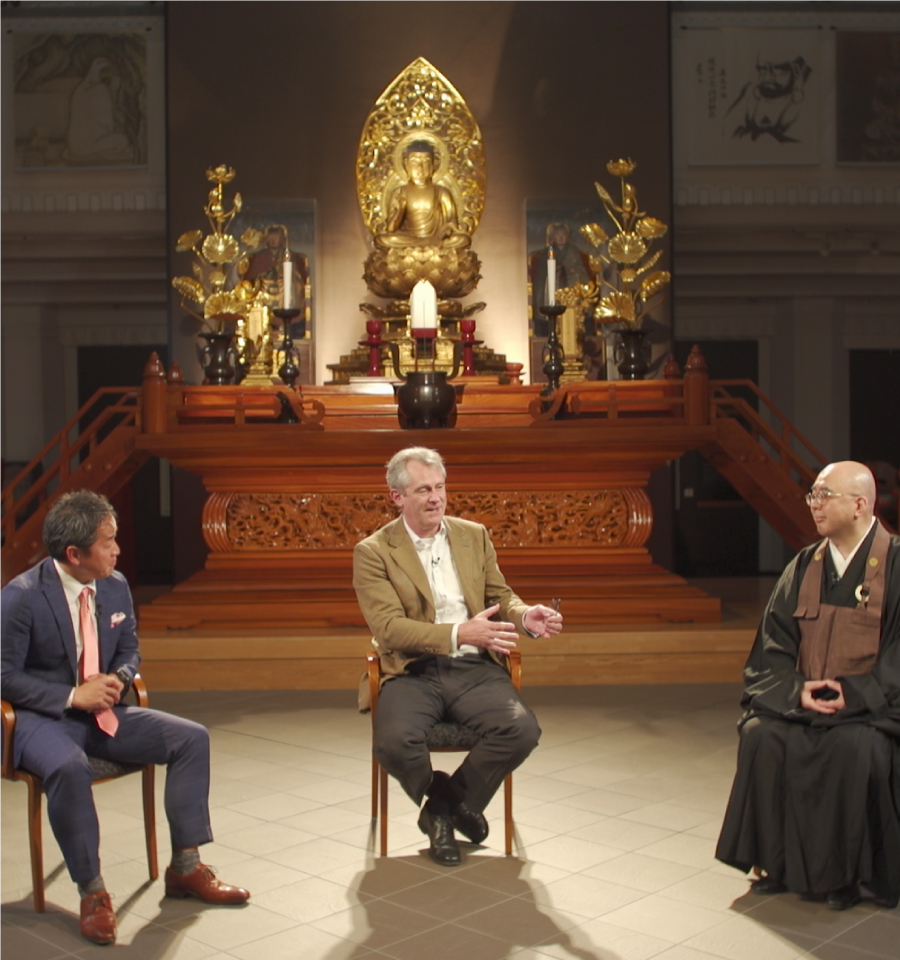
ZEN,KOMAZAWA,MANAGEMENT
For our 5th discussion in this series we welcomed guest participant Mr. David Atkinson, CEO of Konishi Decorative Arts and Crafts, for a three-way discussion on the topic of “Zen and Management” with Professor Hironobu Iizuka, curator of the Museum of Zen Culture and History, and Professor Shigeki Aoki of the Faculty of Business Administration. What is it that we regard as the “essence” of both Zen and business management? Mr. Atkinson spoke about what he sees as the ideal form that traditional culture should take.
*This discussion was recorded in March 2020.
Studying Japan's economy during his university days
Aoki:Hello, and thank you for joining us.
Atkinson:Hello.
Aoki:Today we are discussing “Zen x Management” as part of our Zen branding project, and we are pleased to introduce as our guest Mr. David Atkinson, who has an extremely broad knowledge of business management in Japan.
Aoki:Mr. Atkinson is CEO of Konishi Decorative Arts and Crafts, which employs craftsmen who restore and maintain Japanese temples and shrines.
Aoki:Established in 1592, the focus of the research activities of Komazawa University is centered on Buddhism, and especially Zen Buddhism. Representing the university, we also welcome Professor Hironobu Iizuka, curator of the Museum of Zen Culture and History. Thank you both for joining me today.
Iizuka:Thank you for having me. Mr. Atkinson, thank you for coming.
Atkinson:Thank you for inviting me.
Iizuka:This will most likely be the last discussion in this series held here at the Museum of Zen Culture and History, and so I am very pleased that we have been given this opportunity.
Atkinson:It is an honour to be here. Thank you.
Iizuka:I'm looking forward to our discussion.
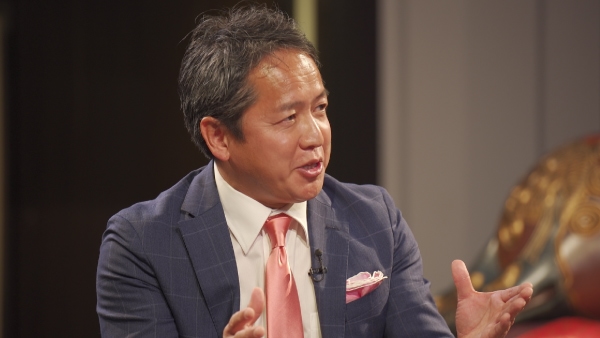
Aoki:First of all, Mr. Atkinson, you studied at the University of Oxford. You were raised in the UK, and I understand that you majored in Japanese studies. Could you please tell us about how you became interested in Japan?
Atkinson:I became interested in Japan not because of the culture, but rather because at that time the economic situation in the UK was extremely bad, and the number of employment opportunities there was limited. The Japanese economy at the time had the highest growth in the developed world and practically nobody was studying it. I therefore began learning about Japan because I thought it would be a tremendous advantage when I was job hunting.
Aoki:So, prior to that you had no particular interest in Zen, Japanese culture, tea ceremony, or any of those things?
Atkinson:None at all.
Aoki:No interest at all. (Laughs) So, after you actually began learning about Japan, what was your impression?
Atkinson:What can I say? I was learning about Japan as a means of finding employment, so it wasn’t a matter of whether I was interested in Japan itself or not.
Aoki:So you had no interest whatsoever?
Atkinson:That was not my reason to be studying Japan.
Aoki:Did you start learning Japanese for the first time at university?
Atkinson:Yes, that’s right.
Searching for social interaction through Japanese culture
Aoki:I also heard that you are very knowledgeable about tea ceremony.
Iizuka:I was studying a Buddhist monk called Ikkyu Sojun who was a priest of the Daitoku-ji school of Zen Buddhism. He lived from the Northern and Southern Courts period, in the 14th century, until around the end of the 15th century, a period that coincides perfectly with the development of tea ceremony. Daitoku-ji Temple became a centre of tea ceremony, with various tea ceremony traditions prospering there. Coincidentally, one of the museum’s policies is to collect materials related to the Buddhist monk Ryokan, and I saw that there was an article in the magazine Me no Me written by Mr. Atkinson. Although I didn’t read all of the article, Mr. Atkinson seemed to be profoundly knowledgeable and a practitioner of the tea ceremony himself. I would very much like you to tell us about this.
Atkinson:It’s been around 20 years since I first took up tea ceremony. At that time, although I was living in Japan I spent most of my time analyzing Japanese banks, and interacting with business people mostly in the financial community. I began to realize that my world was far too narrow, and I was not taking advantage of bein in Japan. I decided to study something traditional. When I started looking around I found that much of traditional Japanese culture is an interaction largely between the teacher and the pupil. For example, you practice calligraphy by yourself, although you do have a relationship with your teacher. Flower arrangement is pretty much the same—the conversations that you have are with the flowers more than people. That is why I decided to practice tea, because you can invite guests and enjoy art and tea with them.
Aoki:I’m sure the sense of speed in business and that in tea ceremony are quite different. Is there a similar tradition in the UK? What did you find interesting or profound about the tea ceremony?
Atkinson:That was not my thought process. Every country has its own distinct culture, and within that there are many options to choose from. Among these options, there are some things that can only be done in Japan, and I thought that doing one of these activities would be enriching for my own life. In that sense, I first started studying tea as one option rather than because I was deeply motivated to study it.
Aoki:I see.
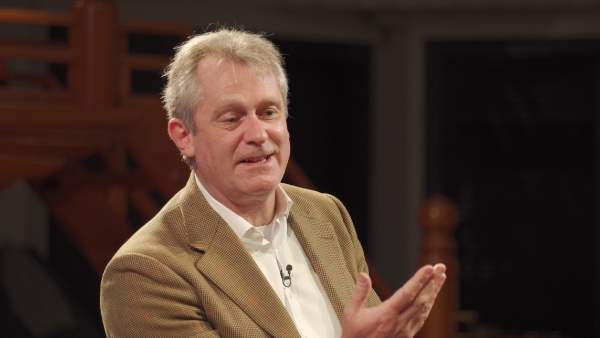
Alienation from traditional culture
Aoki:However, as an extension of your involvement in tea ceremony, you then switched your business interests to a company that actively preserves and maintains traditional Japanese culture, Konishi Decorative Arts and Crafts. What led you to this decision and what were the challenges you faced?
Atkinson:I have a holiday house in Karuizawa, and the house next door belongs to the previous CEO of Konishi Decorative Arts and Crafts. I had retired from finance and had no intention of returning to work when my next-door neighbour asked me if I would manage her family company. I think that this is consistent with me learning Japanese or studying tea. I joined not because I really wanted to protect Japanese heritage. Rather I joined the company because a friend asked me to, and the company just happens to protect Japanese heritage.
Aoki:I see. Professor Iizuka, you manage a temple, so you are truly in a position where you have to manage Japanese culture and traditions. What difficulties do you encounter?
Iizuka:What Mr. Atkinson was just saying was deeply intriguing. I think it all comes down to interpersonal relationships. Of course, interest and necessity also play a role, but I believe that these factors change tremendously through the influence of other people. In addition to running a temple, I also have to train human resources, conveying the various things that I myself have learned to the next generation.
Iizuka:For example, in light of my poor imaginative skills, how can I convey the skills of a master builder to the next generation? In such a situation, I think that teaching/learning through a one-on-one relationship between master and disciple, like a tea master, is probably the traditional method for passing on arts and skills, and it is the same in Zen Buddhism. Disciples learn from a master, with knowledge fundamentally passed on directly through menju (“face-to-face teaching”) in the words of Dogen Zenji. With respect to Mr. Atkinson’s company, I feel that there was an element of fate in how matters came about, but I also feel that the biggest problem here would have been disconnection, and so as the chief priest of a small temple in the countryside, I am quite interested in how the company has preserved in the midst of a difficult period for company employees when the family was unable to continue operating the business. “Interested” in the sense that it must have been difficult.
Aoki:Mr. Atkinson, having become involved with a company that is in fact very “Japanese”, what elements do you think could or should be changed in order to make preservation/management of such a company possible?
Atkinson:Many people say to me, “This is a traditional company” or “The company preserves and passes on traditional skills”, but in a sense, these “traditional skills” were actually ordinary everyday skills up until the Edo Period. Konishi Decorative Arts and Crafts is Japan’s biggest lacquering company, but until paint was introduced to Japan from the West, “painting” meant applying a coat of lacquer. Although this is probably no longer the case, the truth is that in those days there were lacquered objects and lacquering in every Japanese home. In practicing tea ceremony, I get the feeling that traditional skills are being “glorified” way too much, which concerns me because what this does is create distance.
Aoki:Distance?
Atkinson:Yes, distance. In the past, lacquer trees were planted around fields, so anyone could play around these trees, touch them, and probably get a rash from doing so, but nowadays you rarely see any lacquer trees. With regard to lacquering inside homes, I’m pretty sure that contractors building houses today almost never lacquer anything. In the past, there would always have been some place in the home—the tokonoma alcove, for instance—that was lacquered, but that’s not the case today. Glorifying something that was once ubiquitous creates a sense of distance, causing people to say, ‘Those artisans had amazing skills.’ I read somewhere, ‘You don’t need a sword to kill an artisan. If you don’t employ their skills, they’re just ordinary people.’ I think those words are extremely true. II think the same is true of the tea ceremony. I think it was a terrible mistake for cha-no-yu (tea ceremony), which you were just mentioning, to become sado (the “Way of Tea”). Rather than enjoying sharing tea with others, people who practice tea ceremony became tea teachers and tea masters, which led to the idea that people who practice tea ceremony are special. This discourages many people from exploring the word of tea. Consequently, the way of tea becomes something that other people do, not something that you do yourself. I think that this distancing is what started the decline in Japanese culture.
Aoki:That is so true for temple management. My grandfather was also a Buddhist priest, but the relationship between the temple and the local community is breaking down and society is so divided that these days there are few opportunities for people to interact with Buddhist temples or priests except through their role in the performance of Buddhist funeral services. What are your thoughts about this, Professor Iizuka?
Iizuka:This is no longer the case for my temple, but in the past, the temple was truly a place where local farmers would come to drink a cup of tea as a break from working in the fields.
Iizuka:There were priests at the temple, and in our case, there was also my mother, and so in a sense, the temple was a place where local people could come to relax and talk about small concerns over a cup of tea or perhaps even seek consultation about a problem they were having. With regard to deification and creating a sense of distance, I think that these are matters in which we have failed tremendously. Until very recently it was the true role of the temple to be a “place where people can visit” or where the “threshold wasn’t very high”, but we are located in the countryside, and in truth there has been a sense of estrangement that has been gradually increasing. For us, too, lacquering and lacquered objects are a normal part of everyday life, and we use wooden soup and oryoki bowls with peeling lacquer on an everyday basis. And with regard to Buddhist mortuary tablets, it’s also normal for them to be lacquered, but I think the reason that these are becoming more and more expensive is that people are no longer ordering them. Since they are certainly expensive, people will no doubt stop using them in the future. This means that we will need to search for a substitute, and so I think that such issues are piling up one by one, and affecting more than just temples.
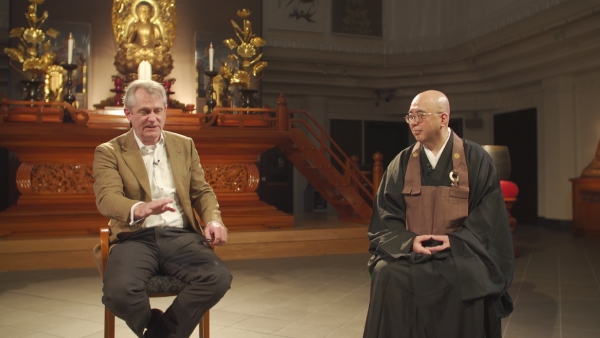
Essence
Aoki:Next, I’d like to ask about Western culture. The decline in lacquer usage in Japan was, in a sense, a consequence of the material wealth brought by the Industrial Revolution. In Japan’s case, especially after the end of feudalism, and after the Second World War, the Japanese economy grew rapidly through the exporting of cheaper but well-made manufactures. I believe that this led to Japan’s period of high growth. Mr. Atkinson, having been educated in the UK, what are your thoughts on Western strengths or Western perspectives?
Atkinson:In Japan, people often say, ‘This is an Eastern way of thinking’ or ‘This is a Western way of thinking,’ but is it that easy to generalize? I am extremely sceptical of such blanket characterizations. Humans are basically the same, and everyone is basically behaving in the same way, although there are superficial differences in how that is achieved. I wonder how many fundamentals differences there really are.
Conversely—and this may be a rude thing to say to Japanese people—I would like to ask, ‘To what extent have Japanese people really understood Western culture, its true essence?’ Every time I switch on the television someone is saying, “Well, that’s a Western way of thinking…” However, I often feel that the “Western culture” being presented on television is at best a very superficial understanding.
I only know the teaching methods of the University of Oxford, and I comment about what education is like at other universities. The education I received at Oxford was founded on a search for the fundamental essence of things.....
Is that also a Zen concept?
Iizuka:Actually, the more you think about “what it means to pursue the essence of things”, the deeper into the labyrinth you go. The reason for this is that in Buddhism there is the concept of “dependent co-arising・nothingness,” On the one hand, this concept is interpreted by some to mean that, fundamentally, nothing has essence. On the other hand, despite saying that “Spiritual enlightenment can be attained only through the communion of mind with mind”, within Zen Buddhism many Zen masters—whether they are speaking about Zen thinking or seeking its essence—are fundamentally endeavouring to experience the world of “dependent co-arising・nothingness” vicariously through self-establishment and daily self-denial.
Iizuka:Forgetting the frameworks of “Eastern” and “Western”, with the passage of time, skills are deepened, senses are sharpened, and experience is accumulated—all of which leads into new territory. What I’m trying to ask Mr. Atkinson is, in a sense, isn’t it possible to consider the deepening of Zen thought and the deepening of skills on the same level? This is my personal opinion. I cannot answer the question, “How do we seek essence?”
Atkinson:Fascinating. Well, even though I run a company that provides traditional craftsmanship, and while traditional skills may be traditional skills, a company is still a company. and I do not think that running this company is fundamentally different from running any other type of company. Ironically, there are actually many decisions implemented by the previous—Japanese—managers that I have reversed.
For example, despite the fact that Konishi Decorative Arts and Crafts is a company that lacquers Japanese temples and shrines that are designated as National Important Cultural Properties, inexplicably the lacquer being used was 70% imported from China. When I asked why Chinese lacquer was being used, nobody had a good answer. As a result, I had the company go back to using 100% Japan-made lacquer which is what would have originally been used. There have been so many cases in which people do not question whether or not something has to be the way it is.
For example—and this is something I am actually attempting to tackle right now, but I think the issue is the same—there is the deeply rooted belief that “it takes 10 years to train an artisan”. When I asked, “Why not two years? Why not five years?”, nobody could give me an answer. In the past, maybe it took ten years because the pace of life was so different, but I think you need to actually question that—seek the essence of the matter, and ask whether or not the same training could be achieved in a shorter period.
The other day I just happened to see on television a program about hair cutting. Training for hair stylists normally takes three years, but it apparently the training can be completed in six months if taught differently. I understand that spiritual training in the world of Buddhism is hard and time-consuming, but the workplace should not be spiritual training, and I am sure that there is no need to make a 6-month process take 3 years.
Atkinson:When the training period was reduced to six months, the drop-out rate apparently fell dramatically. By asking if training really had to last 3 years, it became easier to hire people and they could be promoted to positions of responsibility much earlier. There are so many difficult issues facing us today, and I believe that is therefore so important to question why things are the way they are.
Aoki:With regard to methodology, Karl Popper (a British philosopher) said that growth begins by first of all questioning the current conventional wisdom. As Professor Iizuka also mentioned, from criticism, growth is achieved by constantly asking and answering your own questions. I got the feeling that this is the basis of human growth.
Elite education at a famous British university and in the Soto school of Zen Buddhism
Atkinson:May I say something?
Aoki:Please, go ahead.
Atkinson:This is a point that is very important to the University of Oxford—in fact, the entire university system in the UK. The Japanese phrase you just used to translate critical carries the meaning of criticizing something which includes saying that something is bad or wrong. However, in academic circles, “critical thinking” is used in a different sense. It means to give an opinion of judgement. The word in Japanese is also different. This is a common misunderstanding also in the U.S. and U.K.
Aoki:Yes, that’s right, Critic.
Atkinson:The most important skill in modern life is critical thinking.
Aoki:If you say “criticise”, students in particular mistakenly think that it means something like “questioning someone’s worth as a human being”, but if you carefully teach them that “criticise” and “critique” have different meanings, they understand. I have the feeling that the mistranslation in this case is actually on the Japanese side. In that sense, while we say that critiquing is very important in education on the one hand, on the other hand, what has been the situation with education in Japan, and with education within Buddhism?
Iizuka:I don’t know anything major, but naturally in the past it was extremely important to study Chinese classical literature as well as various aspects of Chinese culture, thinking, and history, etc. Mainly it was elites who had these abilities.
However, in our school of Buddhism, importance is placed on training as many people as possible. With the sect expanding into regional areas, “elites” lose their eliteness. For this training we have kudensho (oral records) by which masters pass on their know-how through a kind of oral tradition, and there is a system referred to as Kirigami(literally “paper strips”) whereby various detailed instructions—such as how funeral services should be performed, or which direction the head should face in a funeral service—is passed on by the master, and this system was clarified in the form of Sanmotsu sosho (three disciplines secretly instructed by masters) during the Warring States Period (1467–1567) through the Edo Period (1603–1868). So while saying, “Watch what I do”, “Spiritual enlightenment can be attained only through communion of mind with mind” and the like, Buddhist masters actually passed on their teachings to disciples in detailed written instructions. Zen Buddhism has two ango (periods of intense training for disciples), held in the summer and winter, and there was a system whereby monks travelled around various regions listening to the teachings of various Zen masters over a period of 90 days in order to acquire general knowledge.
Iizuka:My understanding is that such systems were how Buddhist priests were trained in the past, with their education comprising a balance of both one-on-one learning from their master and a 90-day period of general training.
Aoki:Isn’t this the same as the education system at the University of Oxford? Professors teaching students in a one-on-one tutorial style…
Atkinson:Well, in the UK that system is only employed at the University of Oxford and the University of Cambridge, and as you say, there are hardly any formal lectures. At the end of three years, there is a week in which students have examinations for around six hours each day, and your degree is decided on these examination scores. There were no credits. It’s quite an unusual system. Every week my would ask me to write a paper on such-and-such a topic by the following week’s tutorial. They did not tell us what to study or which books to read, so we went to the library, searched out materials related to the theme we had been assigned and wrote a paper presenting our understanding of the theme, which we then read aloud. This reading was usually cut short after the first one or two sentences. (Laughs) My tutor would ask—“Interesting…” or “What do you mean by that?”. Each tutorial lasts for about an hour, and when it was over I would truly want to sleep for a week; it was so mentally draining and studying for it was really very difficult. At the end, my tutor would ask me to write another paper on a different topic, and this was repeated over and over again. It was really tough.
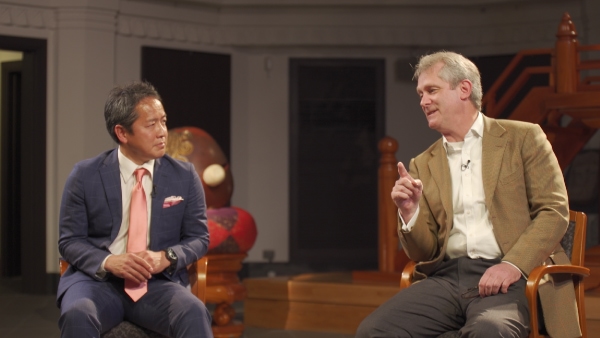
A tourism industry more like religious training?
Atkinson:Going back to questioning whether things have to be the way they are. Firstly, we often have no way of knowing whether the way things are today has always been the case. Just because something has been the same way for a long time does not mean that for example it has been that way since the Yayoi period (1,000 BC – 300 AD). The way something is is the way it is today—nothing more and nothing less. In the case of Zen Buddhism, there may be records that can tell us how things were far back in the past, but there are very few records detailing the craftsmanship of the past. Therefore, it is necessary to question whether the current way of doing things is the best way, or whether something justified by tradition is actually authentically traditional.
Atkinson:I think that the biggest problem facing the Japanese economy is the myths that have grown up around it which have little or no basis in fact, and are not even historically justifiable. For example, the tea ceremony changed after the war when it became very popular with women. As a result the tea ceremony today is almost certainly not the same as it was 100 years ago, and suggesting that it is a tradition unchanged down the centuries is incorrect. Therefore, the current form cannot be the only form it can take, since the current form itself is a recent development.
Aoki:I see. I sense that the fact that when something of value has been systemized, the way to create the system totally differs depending on the historical background and there may be quite a few elements that are incorrect tells us that we need to “go back to the basics.” Under these circumstances, when considering what should be done about Japan’s economy moving forward, I think that it is actually Mr. Atkinson who is advocating change in the greatest variety of forms. In particular, when talking about how to make aspects of the tourism industry more attractive, the most well-known example is that of France, which has become the top tourism destination with just under 90 million foreign tourists visiting the country. Under the Koizumi Administration, Japan had a mere 6 million foreign visitors, but now there are apparently more than 30 million. That being said, this number is still only around one-third of the number of foreign tourists visiting France in Europe. So then, the question is how to increase added value. In the case of Europe, to start with, the aristocracy undoubtedly began visiting southern France and Paris more and more on so-called vacations during the period 100 years or so ago known as the Belle Époque (1871–1914). Over time, horse-driven carriages changed to cars, and companies such as Louis Vuitton and HERMÈS began making their famous products; the Hotel Ritz was built, and owners of the Hotel Ritz and the Escoffier restaurant designed restaurant menus together. Products with quite high added value were matched with associated items along with services. I think that this mythology is probably still providing the appeal that draws 90 million visitors to France even after 100 years or so. What about Japan moving forward? For starters, we have been able to draw as many as 30 million foreign tourists, but from your perspective, Mr. Atkinson, with the industry capable of aiming for far, far greater added value, what methods are there for achieving this?
Atkinson:The purpose of improving the tourism industry is to invigorate regional areas in Japan. Tokyo is a very easy place to live and get around in. The concentration of products and services into one location means that from the standpoint of economic rationality, everyone woud live in Tokyo. If you are thinking just in terms of extreme rationality, that is what would happen. If you think about it, the only reason people live in the countryside is an historical legacy.
Atkinson:In the past, people lived in regional areas to produce silk thread or other products that can only be produced in the country.
Aoki:That also includes forestry and the making of charcoal.
Atkinson:Since none of these now requires large numbers of people to live in the countryside, the only path that remains to sustain the countryside is to nurture the tourism industry in these regional areas. The point of the tourism industry is to enable people to become one with nature—which cannot be found in cities—and relax and reflect on fundamental questions such as “Why are we alive?” When someone states that “There’s no need for that many people in the countryside!”, everyone probably thinks that that is an extreme view. Nevertheless, if you really think about it, there really is not that much of a necessity for people to live in the country. Creating a tourism industry in regional areas creates other industries and paths for the people who live there, and so that is the aim of tourism.
Aoki:When someone is talking about the tourism industry these days, as we listen I think that we are probably going to be premising our thoughts on images of old-time hot spring resorts or group tours. Mr. Atkinson, what steps do you think are lacking for the realisation of the tourism industry that you yourself envision?
Atkinson:In the feudal past, what the people who lived in Kyoto or Edo, for example, did to relax and relieve the stress of what was for them modern times was go to the mountains to practice asceticism. This is a bit different from going to stay at a hot springs resort for just one or two nights before coming home, which is the bulk of current domestic tourism. This is not what I envision for tourism in Japan. In a sense, my vision is something like the Kumanokodo pilgrimage route, with people taking a week and becoming one with the natural environment in which people originally lived. When I became involved in the tourism industry five years ago, the marketing of tourism in Japan was centred on tea ceremony and various other aspects of traditional culture, but to start with, no tourist is going to practice tea ceremony every day of a two-week trip. If you are going to the beach, a one- or two-week stay is possible, and if you go to the mountains, you can enjoy bonding with nature while trekking. In that sense, I believe it is essential to enable international tourists to fully enjoy Japan’s magnificent nature while also experiencing traditional culture. The Japanese Government is currently in the midst of implementing these ideas.
From my perspective—and I’m repeating what I just said—if you asked me, “What was tourism in Japan originally?”, I think that the originally tourism in Japan was focussed on becoming one with nature and practicing asceticism. Long ago, when people visited Mt. Koya, they may not have been there for that long, but the journey to get there was took a long time. In a sense, the purpose of the Kumano pilgrimage was to just walk and walk through the beautiful natural scenery. Historically, visiting the Ise Grand Shrine also took hardly any time at all, but the trip there and back took several weeks, all the while walking through the forest, and that experience was very fulfilling for people. This is an aspect of tourism that I personally feel has been lacking in Japan since the building of the railways, and by restoring this aspect now, I think that the tourism industry is gradually transforming into one that can draw many more visitors.
Aoki:I see. Who do you envision as the targets for this tourism?
Atkinson:I would like to think that everyone in the world would come and visit Japan, so that means 7.5 billion, and that they would all find somthing here that fits with their interests. However, although tourism is nominally being improved for the benefit of foreign visitors, it is actually Japanese tourists that the tourism industry also needs to attract, but in a different way. Japanese tourists don’t stay for long periods; they can’t take long holidays. From my perspective, this is because there are no tourism facilities that people want to take a long holidays to visit, a vicious circle. If such facilities were actually created, I believe that many Japanese people would come. So the one of the reasons Japanese people don’t take a week’s holiday is simply that they have no compelling reason to do so. If we actually created such tourism facilities, the tourism industry could possibly be transformed into something completely different. For example, it was said by many that Japanese people would never pay such exorbitant prices to ride on the Seven Stars in Kyushu Train Cruise. Well, 99.9% of passengers are in fact Japanese. Interestingly, the more expensive the attraction you create, the more likely the largest percentage of visitors will be Japanese. Despite people saying that Japanese people have no money, that Japanese people don’t spend money on such things, if you actually create such an attraction, the evidence is completely different. The reason why such attractions haven’t been created, why they haven’t been envisioned, is that no one has done the analysis, no one has asked questions. The so-called “common knowledge” turns out so many times not to be true. To me, it seems to be nothing more than an ill-thought-out idea, sentimental folklore.
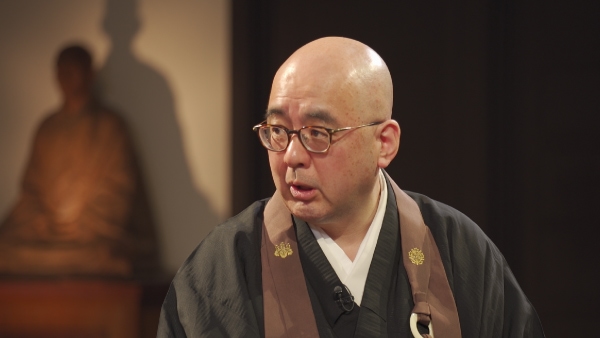
The future of university education
Aoki:Mr. Atkinson, you’ve told us about first of all questioning things that have become habitual or conventional, as well as thinking about the essence of things. In terms of our school education, do you have a message or any thoughts that you would like to share with our students, who will create the future?
Atkinson:Critical thinking. Question everything.
Aoki:In a nutshell.
Atkinson:The same applies to how universities teach. You need to question, “Why do we do things this way?”, “Is this still appropriate now?” “Do we need to improve it” “Should we revert to how things were previously?” Try doing an objective analysis. Preserve whatever should be preserved, and change anything that should not be preserved. This is very obvious but not common in Japan now but Japan more than any other country needs to think about this. If the population were still growing, it would be fine to leave things as they are and ride the wave. Nowadays, however, Japan’s population is declining, and so the choice of whether or not this or that should be preserved needs to be made on a daily basis. The number of universities is one example. At its peak, the number of children born in Japan every year was 2.7 million, but this has fallen to less than 900,000 today. The number of children has dropped by two thirds. However, the number of universities has actually increased.
Previously, children comprised quite a large percentage of Japan’s population, and so it was logical for university education to be provided for mostly children. Several decades later, however, children now comprise less than 20% of Japan’s total population and their numbers continue to decrease. Despite this, the remaining 80% of Japan’s population has traditionally not been targetted by the universities. It’s said that universities have no future, and if universities are considered only as places for educating children, then the future is certainly dark. However, 80% of Japan’s population is living longer and longer, and so I think what is needed is a change in thinking. In the past, people died in their 40s and 50s, so a university education could be used for 20 years. That suggests that you need to go back to university to study when you hit 40 years of age. And then again when you hit 60 years of age. And yet again when you hit 80 years of age. I personally believe that if we change how we think, the future of universities will change. Whether or not this idea would be the right way to go I cannot say as I am not an expert on university matters, but I think it is one scenario that is worth considering.
Aoki:Actually, right now there is much talk about “recurrent education”, but our university has students who are studying Buddhism, many students who are older and retired, and so in that sense I would like for us to question the style of our education up until now and create new mechanisms.
Aoki:To conclude, could we also have a comment from you, Professor Iizuka?
Iizuka:I am growing older and older, which is making me think in particular about various aspects of life. Say, for example, that I work until age 50 or 60, and when I can see that milestone looming in front of me, I will also have to think about my lifespan and the fact that I will eventually die myself.
Our department is the Department of Buddhist Studies, so our education and research are centred on Buddhism. I believe that these studies can show people—not just young people, but particularly older people, people who have had suffered through many experiences within their families or society, and people who have been affected by various hardships, illness, or disaster—that somewhere there may be a light or a path for them to follow, although this is not some kind of prescription for happiness. In addition, Buddhism has an extremely rational way of thinking, and I think that learning how Buddha and the Dogen Zenji explained this is extremely meaningful, and so we hold open lectures on Saturdays and Zen meditation sessions on Sundays. I would very much like everyone to come and join these events. As Mr. Atkinson said, (general) universities target young people, and certainly this is the population group that will be sitting for university entrance examinations in the future. However, since the number of people outside this group will increase more and more in the future, I would like those people to also come to our university.
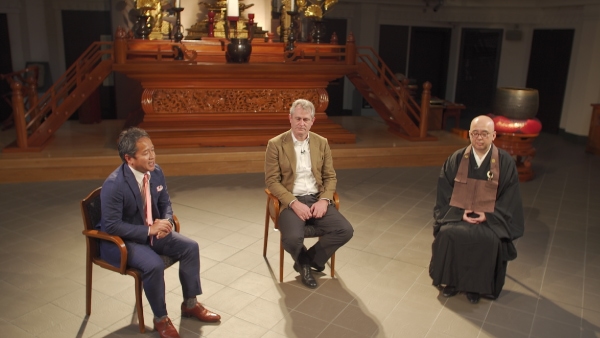
Willows are green and flowers are red
Aoki:Mr. Atkinson, to conclude I would like to ask you to share with us any Zen phrase that you especially like.
Atkinson:I own a hanging scroll with the four Chinese characters for “Willows are green and flowers are red”. When I was working at Goldman Sachs, I used this Zen maxim as the title of my reports sent out to clients. I think people throught I had gone a little batty (laughs). In his book, the Buddhist monk, Arima Raitei explained the meaning of the phase as being,“There is value in questioning whether or not willows truly are green”. Your ultimate answer may be that “Yes, willows are green”, or it may not. By asking the question, even of something so mundane, you may findthat indeed willows really are green, but you will see them as having an even more vividly green colour. If you find that they are not, in fact, green, then you will have made a new discovery. The meaning of this seemingly banale maxim is thus “Why not try exploring the natural state of things?”
I used this as the title of a report, as it was, just six words, when I analysed assumptions that at the time were taken for granted as common sense in bank analysis. I had discovered that these assumptions were completely unfounded. I wanted our clients re-consider whether the accepted wisdom—that is, the willows—was actually true or not. I flatter myself, but it was one of the mst popular of the many reports that I wrote during my 17 years in finance. The report was also translated into English using the direct translation of the Japanese title as is—“Willows are green and flowers are red”—which was somewhat confusing for overseas readers. Our client salespeople told me that overseas readers were surprised to learn about this Japanese maxim and the values it represented.
I think that this way of thinking is also valid for the tea ceremony. Nowadays there are so many rules for the tea ceremony—“Sit before entering a tea room”, “Bow once before the hanging scroll”, “Turn the tea bowl three times before drinking”—but I have extreme doubts that all of these rules are original or even necessary. The purpose of the tea ceremony is to consumeshare a bowl of tea with your guests. Certainly, from a professional standpoint, etiquette is very important. In performing the tea ceremony, I think that it is much easier if all the participants abide by the same rules. However, if you said to children that they had to learn all the rules of soccer first, and then after many years of studying could they finally kick a ball for the first time, who would ever want to play soccer?! I doubt that anyone ever would.
I think a lot of etiquette started from someone doing something that others in the tea room thought was new and "cool". I think that what happened is that someone thought , “Isn't this an interesting way of doing this?” And everyone saw what they did and said, “Hey, that’s a great idea!” and copied the first person. However, over time these became rules to be learned, devoid of the explanation, and there are now rules for absolutely every aspect of tea ceremony, and other people look down on anyone who does not know all of the rules. This kills all of its appeal. That is to say, etiquette should be a method, or tool, for enjoying the essence of tea ceremony, not its main purpose. In other words, there should be a way of tea for the head of a tea ceremony school, a way of tea for a tea ceremony teacher’s tea, a way of for people who sell tea utensils, a way of tea for people who just want to practice tea, and an everyday way of tea. I think that this is probably the case for many traditional cultures, the problem is not that for most people the barriers to entry are high, the barriers are as high as the sky.
Atkinson:In the first place, I think that it would be tremendously valuable to think about why it is that non-Japanese people are more interested in traditional Japanese culture than Japanese people, and the reasons why Japanese people are not interested. When I first saw the scroll “Willows are green and flowers are red” at first glance I thought that it seemed very banal. I was most surprised when I learned its more profound meaning.
Aoki:This discussion has made me realise anew that unless we enter a traditional culture through mechanisms such as firm interest, the practice of that culture can become somehow formal or institutional, and saying that this institutionalisation is “passing down tradition” has been terribly misguided. Through Zen branding, we first of all want to convey Komazawa’s traditional culture to students and members of the general public, and today’s discussion has been extremely informative in that respect.
Atkinson:Thank you.
Aoki:Thank you very much.
Iizuka:Thank you.
 David Atkinson
David Atkinson
CEO of Konishi Decorative Arts and Crafts Co., Ltd.
Visiting Professor, Nara Prefectural University
Formerly Chief Banking Analyst at Goldman Sachs (Japan) Ltd.
Mr. Atkinson was born in the UK in 1965. He graduated from the University of Oxford after majoring in Japanese Studies. After working for a major consulting firm, in 1992 he joined Goldman Sachs Japan, where he was the first banking analysts to quantify the bad debt problems of Japanese major banks. After being appointed to the position of partner, Mr. Atkinson left Goldman Sachs in 2007. In 2009 he joined Konishi Decorative Arts and Crafts Co. Ltd., an over 300-year-old company that restores major shrines and temples as Chairman. He served as both Chairman and CEO from 2011 until 2014, when he was appointed as CEO.
Mr. Atkinson began to study the tea ceremony at Urasenke in 1999, receiving the chamei (the name bestowed upon a tea ceremony practitioner) Soshin in 2006. He has received numerous awards, including the Zaikai Keieisha (Business Executive) Award (2016), Japan-British Society Award (2017), Ministry of Internal Affairs and Communications 2017 Hometown Development Grand Prize (2018), and Japan Fashion Association Creation Award (2018). Mr. Atkinson has published numerous books, including New Tourist Strategy (Toyo Keizai Inc.; winner of the Yamamoto Shichihei Prize and the Real Estate Companies Association of Japan Award); Shin-Shotoku Baizoron (New Income-Doubling Theory)(Toyo Keizai Inc.); Nihon Saisei wa Seisan Kojo Shika Nai! (Increased Productivity Is the Only Way to Restore Japan!) (Asuka Shinsha); Sekai Ichi Otozuretai Nihon no Tsukurikata (How to Make Japan the Most Attractive Tourist Destination) (Toyo Keizai Inc.); Shin-Seisansei Rikkokuron (New Theory of National Commitment to Productivity) (Toyo Keizai Inc.); Nihonjin no Shosan (Can The Japanese Succeed?) (Toyo Keizai Inc.); Kokuun no Bunkiten (Japan at a Crossroads)(Kodansha Ltd.) ; and Nihonkigyo no Shosan (Toyo Keizai Inc.).
While continuing to act as an advisor to the Japanese Government, Mr. Atkinson is also busily involved in promoting regional tourism through his roles and positions in numerous organizations; he is a member of the Japan Heritage Review Board; a Visit Kyoto Ambassador; a member of the Council for the Development of a Tourism Vision to Support the Future of Japan; a member of the Panel of Experts to Consider the Promotion of Tokyo Tourism; a member of the Administrative Reform Council Revenue and Expenditure Reform Working Group; an advisor to State Guest Houses (Akasaka Palace and the Kyoto State Guest House); special adviser to Nijo Castle; a member of the Tourism Strategy Promotion Task Force, a member of the Project to Fully Enjoy National Parks Expert Committee; and a member of the Committee for the Promotion of Easy-to Understand Multilingual Explanatory Equipment.
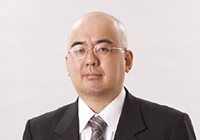 Hironobu Iizuka
Hironobu Iizuka
Professor, Faculty of Buddhism, Komazawa University
Chief Priest of Soto-shu Hosei-in Temple
Born in Tochigi Prefecture in 1959, Professor Iizuka graduated from the Department of Buddhist Studies, Komazawa University, in 1985. He completed his Master Degree in Buddhist Studies at the Komazawa Graduate School, joining the Komazawa University Institute for Soto Studies in the same year. He taught in the Faculty of Buddhism, Komazawa University, as an instructor and associate (assistant) professor before his appointment to his current position of professor.
Professor Iizuka’s field of specialization is the history of Buddhism during the Middle Ages of Japan, and he conducts survey research centering in particular on Zen texts and annotations of texts used in Zen lectures dating from the late Muromachi Period (1338–1573) onwards. In recent years he has been researching eccentric Zen Buddhist monk Ikkyu Sojun and compiling introductions to and commentary on materials in the Daihonzan Eiheiji Temple collection, while in his professorial activities in the University he is undertaking various multifaceted initiatives under the theme of “Zen”.
 Shigeki Aoki
Shigeki Aoki
Professor, Department of Marketing Management, Faculty of Business Administration, Komazawa University
Professor Aoki was born in Sakura City, Chiba Prefecture, in 1968. He obtained his Master Degree from the Graduate School of Business and Commerce, Keio University. After teaching as a professor in the Faculty of Commerce, Yamanashi Gakuin University, and conducting research at the University of Southern California Marshall School of Business, in 2008 he was appointed as professor to the Department of Marketing Management, Faculty of Business Administration, Komazawa University.
Professor Aoki’s research field is the Marketing & Distribution for Sustainability to regenerate companies and societies and to revitalize the regional area with diversity. He also serves as President of NPO Yamanashi Cycle Project and as Academic Producer for Sustainable Brand International Conference Tokyo. His main published works include Marketing Senryakuron (Marketing Strategic Theory), Senryakuteki Marketing no Kozu (Strategic Marketing Structure), and Bunka-o Kyosoryoku to Suru Marketing (Culture Competence Marketing).
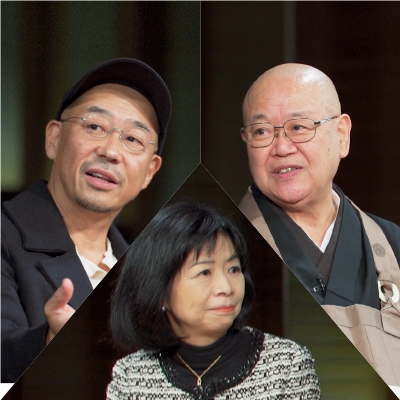
SPECIAL
ZEN,KOMAZAWA,MOVIE
For our fourth interview we welcomed film director Tatsushi Ōmori as our guest, and together with Komazawa University Chancellor Seishi Nagai and Prof・・・
2020.03.05
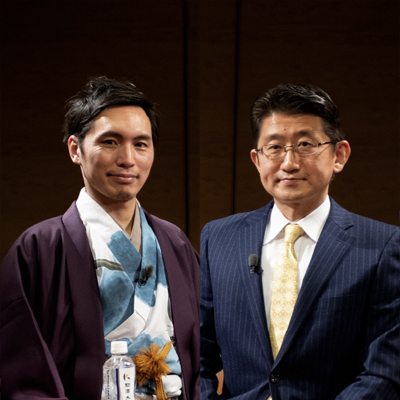
SPECIAL
ZEN, KOMAZAWA, ART
For the third interview in the series, Mr. Satoshi Anzai of the Kyoto artistic unit Daruma Shoten and Prof. Tetsufumi Muramatsu of the Faculty of Budd・・・
2019.09.17

